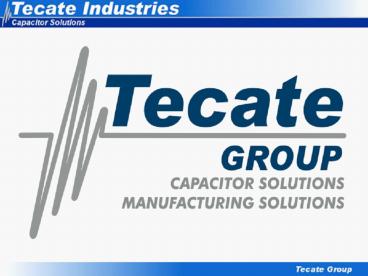What is an Ultracapacitor?: Ultracapacitors Are - PowerPoint PPT Presentation
Title:
What is an Ultracapacitor?: Ultracapacitors Are
Description:
A 100-year-old technology enhanced by modern materials Based on polarization of an electrolyte, high surface area electrodes, and extremely small charge separation ... – PowerPoint PPT presentation
Number of Views:352
Avg rating:3.0/5.0
Title: What is an Ultracapacitor?: Ultracapacitors Are
1
(No Transcript)
2
3
What is an Ultracapacitor?Ultracapacitors Are
- A 100-year-old technology enhanced by modern
materials - Based on polarization of an electrolyte, high
surface area electrodes, and extremely small
charge separation - Known as Electrochemical Double Layer Capacitors
and Supercapacitors
4
What is an Ultracapacitor?Ultracapacitors Are
C er A/d Minimize (d) Maximize (A) E 1/2 CV2
5
Basic Model
- Series/Parallel configurations
- Changes capacitor size profiles are the same
- Series configurations
- Capacitance decreases, Series Resistance
increases - CsCcell/(of cells in series) RsRcell( of
cells in series) - Parallel configurations
- Capacitance increases, Series Resistance
decreases - CPCcell( of cells in parallel) RPRcell/(
cells in parallel) - Current controlled
- Use output current profile to determine dV/dt
- dV I (dt/C ESR)
6
What is an Ultracapacitor?Performance
Characteristics
- Ultracapacitors perform mid-way between
conventional capacitors and electrochemical cells
(batteries) - Fast charge and discharge capability
- Highly reversible process, hundreds of thousands
of cycles - Lower energy than a battery
- 10 of battery energy
- Greater energy than electrolytic capacitors
- Excellent low temperature performance
7
Application Model
8
When Can I Use an Ultracapacitor?
- Applications that require high reliability
back-up power solutions - Short term bridge power (1 - 60 seconds) for
transfer to secondary source or orderly shut down - Power quality ride-through to compensate for
momentary severe voltage sags - Power buffer for large momentary in-rush or power
surges
9
Back-Up Power Support
- Ultracapacitors provide peak power
- ...and back-up power.
10
Peak Power Shaving
- Ultracapacitors provide peak power...
11
Technology Comparison
Available Performance Lead Acid Battery Ultracapacitor Conventional Capacitor
Charge Time 1 to 5 hours 0.3 to 30 seconds 10-3 to 10-6 seconds
Discharge Time 0.3 to 3 hours 0.3 to 30 seconds 10-3 to 10-6 seconds
Energy (Wh/kg) 10 to 100 1 to 10 lt0.1
Cycle Life 1000 gt500000 gt500000
Specific Power (W/kg) lt1000 lt10000 lt100000
Charge/discharge efficiency 0.7 to 0.85 0.85 to 0.98 gt0.95
12
Technology Comparison
Fuel Cells
13
14
Markets and ApplicationsConsumer Electronics
- Market needs include
- Miniaturization
- Burst-mode transmission
- Compatibility with new/divergent designs
- Greater functionality due to merging of protocols
15
Markets and ApplicationsMiniaturization
- Requires smaller/more efficient devices
- Burst Mode Transmission
- Requires compatibility with lower voltage power
supplies - Uses 1/2 voltage but requires at least 2 times
current to maintain same power output - Allows for lower cost primary batteries instead
of rechargeable batteries
16
Markets and ApplicationsUltracapacitor Benefits
- Price/performance/size improvements
- Allows batteries to be sized for energy
requirements, not power - Allows use of alternative, less expensive
chemistries - Extends device use time by up to 100
- Allows primary (non-rechargeable) batteries to be
used for lower cost and convenience - Allows smaller battery size while still meeting
peak power requirements
17
PowerBurst UltracapacitorsCells
- Cylindrical radial leaded devices
- 0.5 Farad to 100 Farad, with other values on
request - 2.7 Volts
- Drop-in replacement to Panasonic, Ness, and others
18
PowerBurst UltracapacitorsModules
- Maxwell parts inside PC5 and PC10 cells
- Active or Passive balancing
- 5.0 Volts to 25 Volts standard customs
- U.S. design and prototyping, Asian production.
- Custom circuits and packaging available using PC
or TPL cells.
19
Ultracapacitor Cell BalancingWhy Cell Balancing?
- Achieve cell to cell voltage balance
- Accounts for variations in capacitance and
leakage current, initial charge and voltage
dependent on capacitance, sustained voltage
dependent on leakage current. - Reduces voltage stress on an individual cell
- Increase overall reliability of the individual
cells
20
Ultracapacitor Cell Balancing
- Low cost
- Scalable balance current
- 10mA, 300mA circuits
- Very low quiescent current (lt20µA)
- No on/off required
- Modular installation
- N cells require N-1 circuits
- Voltage independent
300mA balancer for 50 60mm Ø cells
10mA balancer for 5F 10F cells
21
Ultracapacitor Aging
- Unlike batteries, ultracapacitors do not have
hard end-of-life criteria - Ultracapacitors degradation is apparent through a
gradual loss of capacitance and a gradual
increase in resistance - End of life is when the capacitance and
resistance are out of the application range, and
this will differ depending on the application. - Therefore, life prediction is easily done
22
UC Benefits Summary
- Calendar life
- Function of average voltage and temperature
- Cycle life
- Function of average voltage and temperature
- Charge acceptance
- Charge as fast as discharge, limited only by
heating - Temperature
- High temp no thermal runaway
- Low temp -40C
23
UC Benefits Summary
- No fixed VOC
- Control flexibility context-dependent voltage is
permitted - Power source voltage compatibility
- Examples Fuel cells, photovoltaics
- No Vmin
- Cell can be discharged to 0 Volts
- Control safety no over-discharge
- Service safety
24
UC Benefits Summary
- Cell voltage management
- Only required to prevent individual cell
over-voltage - State of charge and state of health
- State of charge equals VOC
- Dynamic measurements for C and EST equals state
of health - No historical data required
25
Inventory Management Services
- Warehousing and Material Management
- N. America Asia
- Schedule Share, Demand Pull, Consignment, EDI
- NPI facility in San Diego for quickturn custom
modules. - Third Party warehousing
- Customer specific programs tailored to individual
needs































